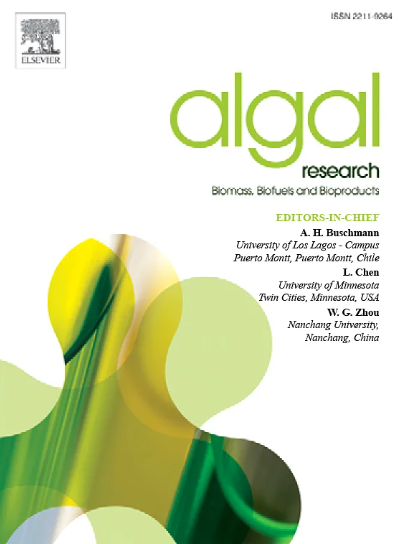Correlation analysis between pH value of Yingna River with environmental factors and phytoplankton in China based on multivariable statistics analysis
IF 4.6
2区 生物学
Q1 BIOTECHNOLOGY & APPLIED MICROBIOLOGY
Algal Research-Biomass Biofuels and Bioproducts
Pub Date : 2025-03-08
DOI:10.1016/j.algal.2025.103991
引用次数: 0
Abstract
The Yingna River flows through Dalian and Dandong, China, before emptying into the Yellow Sea, where the pH value in some areas exceeds the standard limits. To investigate the key factors and mechanisms driving pH variation, the Yingna River, Xiaosi River, and Zhuang River were selected as the study subjects. Results indicate that phytoplankton in all three rivers primarily belong to Chlorophyta and Bacillariophyta, with Chlorella, Cyclotella, and Navicula as dominant species. The Yingna River also has unique dominant species such as Scenedesmus quadricauda, Scenedesmus spinosus and Chroococcus. Its main functional groups are B, J, L0, X1, X2. Environmental factor analysis shows that the pH value of the Yingna River was significantly higher than that of the other two rivers (P < 0.05). Carbonates(CO32‐)was present in the water, while total alkalinity (TA), bicarbonate(HCO3‐, and active phosphorus (PO4-P) concentrations were significantly lower than those in the Xiaosi River (P < 0.05). A generalized additive model (GAM) was constructed for pH with HCO3‐, Chemical Oxygen Demand (COD), CO32‐, and Ammonia nitrogen (NH4-N), achieving an Akaike information criterion (AIC) of ‐22.98, with an explanatory power of 99.79%. The Mantel test demonstrated that pH value, HCO3‐, NH4-N, and N:P ratio were the primary factors influencing the phytoplankton diversity indices. Redundancy analysis (RDA) indicated that pH value, HCO3‐, NH4-N, and N:P ratio were the main factors affecting the dominant species of phytoplankton. This study aims to analyze the relationship between pH and other environmental factors, as well as phytoplankton, providing a reference for the ecological protection and restoration of the Yingna River.
求助全文
约1分钟内获得全文
求助全文
来源期刊

Algal Research-Biomass Biofuels and Bioproducts
BIOTECHNOLOGY & APPLIED MICROBIOLOGY-
CiteScore
9.40
自引率
7.80%
发文量
332
期刊介绍:
Algal Research is an international phycology journal covering all areas of emerging technologies in algae biology, biomass production, cultivation, harvesting, extraction, bioproducts, biorefinery, engineering, and econometrics. Algae is defined to include cyanobacteria, microalgae, and protists and symbionts of interest in biotechnology. The journal publishes original research and reviews for the following scope: algal biology, including but not exclusive to: phylogeny, biodiversity, molecular traits, metabolic regulation, and genetic engineering, algal cultivation, e.g. phototrophic systems, heterotrophic systems, and mixotrophic systems, algal harvesting and extraction systems, biotechnology to convert algal biomass and components into biofuels and bioproducts, e.g., nutraceuticals, pharmaceuticals, animal feed, plastics, etc. algal products and their economic assessment
 求助内容:
求助内容: 应助结果提醒方式:
应助结果提醒方式:


